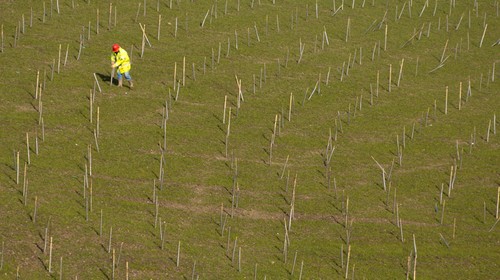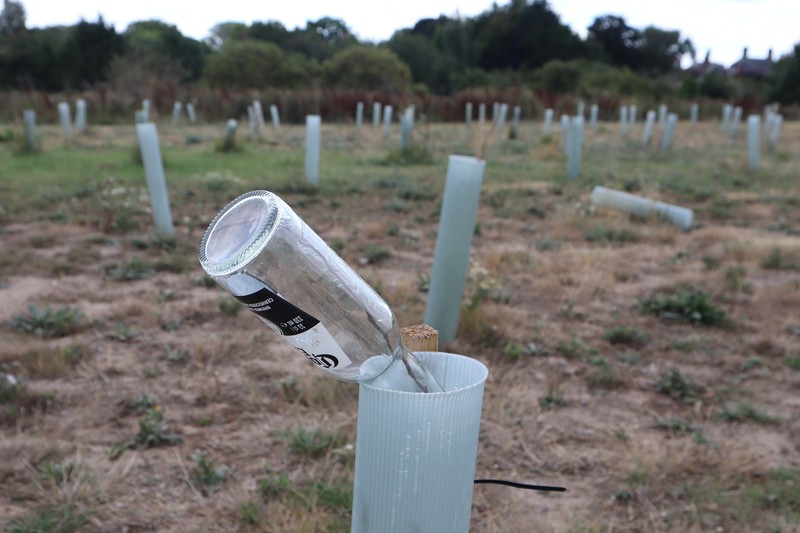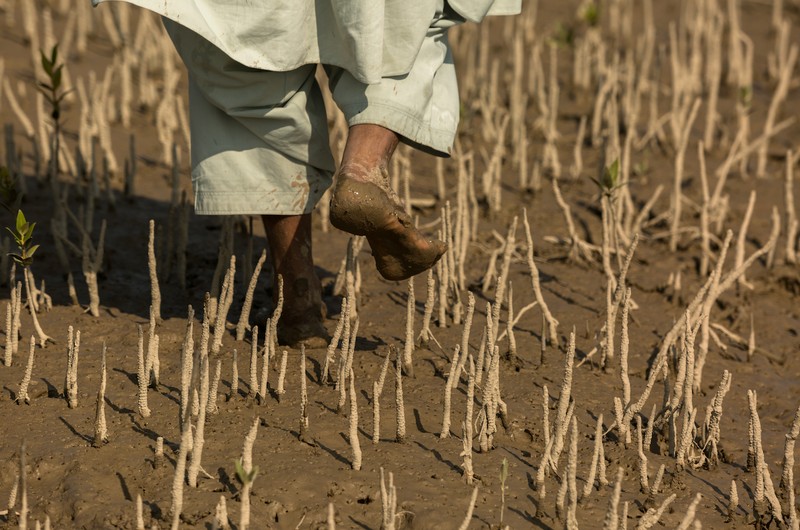Tree Planting Only Creates Tree Cemeteries and The Feeling of Doing Good
 |
AN EXAMPLE OF ONE OF MANY TREE-PLANTING SCHEMES UNDERWAY IN ENGLAND. FILE PHOTO: PAUL BIRCHFIELD/CONSTRUCTION PHOTOGRAPHY/AVALON/GETTY IMAGES |
KING’S LYNN, UK - Thousands of cylindrical plastic tree guards line the grassland here, so uniform that, from a distance, it looks like a war memorial. This open space at the edge of King’s Lynn, a quiet market town in the east of England, was supposed to be a new carbon sink for Norfolk, offering 6,000 trees to tackle the climate crisis. The problem is that almost all of the trees that the guards were supposed to protect have died.
Experts have told VICE World News that not only were they planted at the wrong time of year, but that they were planted on species-rich grassland that was already carbon negative, which has now been mostly destroyed by tree planting. Environmentalists also point out that the trees were planted so shallowly into the ground that most were unlikely to ever take root.
By planting the seedlings in April, instead of in winter or early spring, they never had a good chance of survival anyway.
A pledge to tackle the climate crisis has turned into the opposite of carbon offsetting – all using council funding (they declined to tell VICE World News how much).
“Councils don’t have a lot of money,” Dr Charlie Gardner, a conservation scientist, and local climate activist, told me as he showed me through the site. “There was a lot of good that could have been done with that money. But it’s clear to me that doing good wasn’t ever an objective, it was just seen to be doing something. That’s what makes me sad about the whole thing.”
 |
King's Lynn.JPG PHOTO: SOPHIA SMITH GALER |
Tree-planting initiatives have become an increasingly popular way to offset carbon, with companies and governments around the world committing to reforestation schemes as they deal with the climate crisis. But critics say that tree planting takes decades to benefit the environment, and can be used as ‘greenwashing’ – a way of companies looking good while failing to fully commit to decarbonization and divesting from the fossil-fuel industry.
The tree-planting scheme had been hailed by local conservative Councillor Paul Kunes, who has a position in the local cabinet for the environment, as “the first large-scale planting program as part of the borough council’s strategy to tackle climate change and offset carbon dioxide emissions.” The council has put aside £1 million over four years to deal with climate change, and he said this tree planting would reduce carbon dioxide “by approximately 149,500kg per year.”
VICE World News asked how much the tree planting scheme cost the Borough Council of King’s Lynn and West Norfolk, but it would not disclose the figure – they simply said they had put the contract out to tender.
But an evaluation Gardner did two weeks earlier of 150 trees from across the site revealed 135 dead tree seedlings – a survival rate of just 10 percent.
As we walk through the grassland, it’s possible even more have gone. He says that if the seedling snaps in his hands, it’s dead; if it has a little give when he bends it, it means that it’s still alive. We spend the next hour walking through the uniform lines, the trees snapping rhythmically. Only in one corner, where the grass looked slightly greener, did the trees appear to have a shot at outliving a summer of British heatwaves, low rainfall, and haphazard planting.
“Species-rich grasslands are a rare habitat,” he explained, pointing out endangered knapweed and other wildflowers that have grown here naturally. “By planting these trees and failing, the council has not only failed to establish a woodland – they’ve actually destroyed a grassland at the same time. So it’s not just a neutral impact or wasted effort, it’s actively a negative impact on the biodiversity of King’s Lynn and possibly also the carbon storage.
“The planters will have disturbed the soil and some of the carbon stored in the soil will be released in that process. They’ve turned a carbon sink into a carbon source.”
Several seedlings seem to have been placed only in the tree guards and not properly planted, meaning that the roots have crawled up the inside of the plastic instead of down into the soil and perished.
The council disagrees with Gardner’s assessment. A spokesperson from the Borough Council of King’s Lynn and West Norfolk told VICE World News: “Our most recent review has identified that between 15-20 percent of the trees planted have succumbed to what we can only refer to as wanton vandalism. This can be seen quite clearly as the sticks and tubes lay flat on the ground having been broken off and, in some cases, the supporting stakes removed completely. This has only served to compound the environmental conditions suffered this summer.”
They added that the area had been selected because it was a large space unsuitable for building on, that the tree plating would complement existing flora, and that in the medium-long term the woodland was anticipated “to be a lower maintenance landscape, not requiring routine cutting like grassland/meadow.”
VICE World News did not see vandalism beyond nitrous oxide canisters and beer bottles lying on some grassland and in some tree guards. We saw an overwhelming number of dead seedlings that had faltered and fallen out of the ground.
This local council may not be the only one in the UK that seems to have made a mess of its tree planting scheme. A botanist, who wishes to remain anonymous to protect their relationships with local government, told VICE World News that Middlesbrough Council also planted trees in April as part of a ‘green month’ takeover “on a sweltering hot day – they had no chance.” They believe “at least” 50 percent have died out of around 100 trees in the Hemlington area of the town.
They added that non-native species to the area had been planted, including a coastal species when the planting site was miles from the sea and that no survey of the local area had been done before the work was done.
Middlesbrough Council told VICE World News that they did not believe this number of trees had died but were unable to confirm any further details.
Phil Sturgeon, the co-founder of Protect Earth UK, which runs tree planting projects every year, has planted 35,000 trees in his career and told VICE World News his projects of similar size “have only lost 5-10 percent” of trees this year, even with the unprecedented heatwave UK experienced in July.
A number of regional and national governments have announced enormous tree planting schemes in the past few years as momentum has built to tackle the climate crisis – and many of them haven’t gone to plan. Hackney Council’s partnership with charity Trees for Cities, which was funded by Coca-Cola’s company Honest Organic, was criticized in 2020 when it appeared that most, if not all, of the 4,000 trees planted had died.
 |
Screen Shot 2022-09-01 at 14.02.46.png PAKISTAN AIMS TO PLAN 10 BILLION TREES. PHOTO: ASIM HAFEEZ/BLOOMBERG VIA GETTY IMAGES |
Environmentalists have criticized Pakistan’s “10 billion trees” project for being an expensive waste of resources and Egypt, which will host the next UN climate conference, claims it will plant 100 million trees across the country.
“There are no quick fixes with this crisis,” Gardner said, looking out across the thousands of dead trees. “Simply planting trees isn’t the answer. If we want these trees to have a real impact, they’ve got to still be alive in 100 years and that means it’s a 100-year commitment, not a 1-day commitment.
“The most important thing is to stop burning fossil fuels. The second most important thing is conserving the nature we already have. Trying to create new nature to absorb our fossil fuel emissions is way down the list of priorities.”
Comments